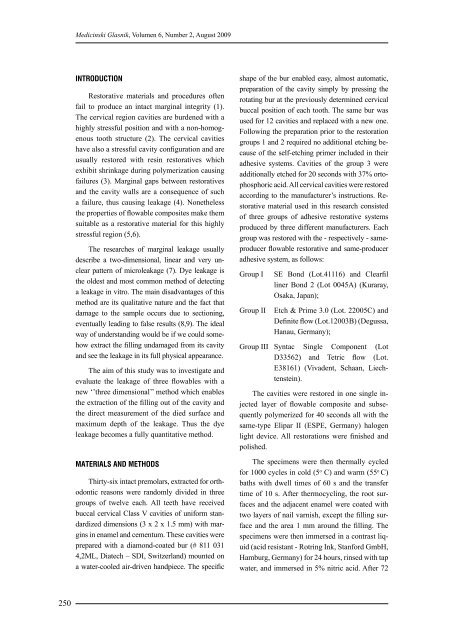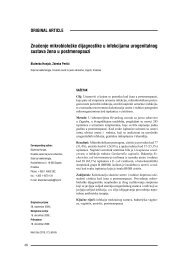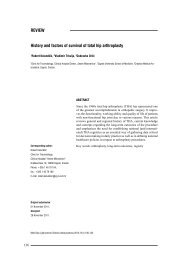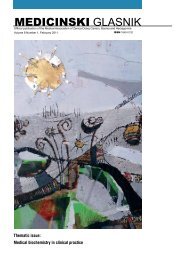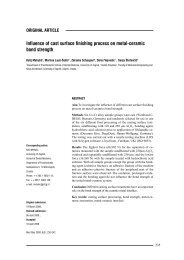MEDICINSKI GLASNIK
MEDICINSKI GLASNIK
MEDICINSKI GLASNIK
You also want an ePaper? Increase the reach of your titles
YUMPU automatically turns print PDFs into web optimized ePapers that Google loves.
250<br />
Medicinski Glasnik, Volumen 6, Number 2, August 2009<br />
INTRODUCTION<br />
Restorative materials and procedures often<br />
fail to produce an intact marginal integrity (1).<br />
The cervical region cavities are burdened with a<br />
highly stressful position and with a non-homogenous<br />
tooth structure (2). The cervical cavities<br />
have also a stressful cavity configuration and are<br />
usually restored with resin restoratives which<br />
exhibit shrinkage during polymerization causing<br />
failures (3). Marginal gaps between restoratives<br />
and the cavity walls are a consequence of such<br />
a failure, thus causing leakage (4). Nonetheless<br />
the properties of flowable composites make them<br />
suitable as a restorative material for this highly<br />
stressful region (5,6).<br />
The researches of marginal leakage usually<br />
describe a two-dimensional, linear and very unclear<br />
pattern of microleakage (7). Dye leakage is<br />
the oldest and most common method of detecting<br />
a leakage in vitro. The main disadvantages of this<br />
method are its qualitative nature and the fact that<br />
damage to the sample occurs due to sectioning,<br />
eventually leading to false results (8,9). The ideal<br />
way of understanding would be if we could somehow<br />
extract the filling undamaged from its cavity<br />
and see the leakage in its full physical appearance.<br />
The aim of this study was to investigate and<br />
evaluate the leakage of three flowables with a<br />
new ‘’three dimensional’’ method which enables<br />
the extraction of the filling out of the cavity and<br />
the direct measurement of the died surface and<br />
maximum depth of the leakage. Thus the dye<br />
leakage becomes a fully quantitative method.<br />
MATERIALS AND METHODS<br />
Thirty-six intact premolars, extracted for orthodontic<br />
reasons were randomly divided in three<br />
groups of twelve each. All teeth have received<br />
buccal cervical Class V cavities of uniform standardized<br />
dimensions (3 x 2 x 1.5 mm) with margins<br />
in enamel and cementum. These cavities were<br />
prepared with a diamond-coated bur (# 811 031<br />
4,2ML, Diatech – SDI, Switzerland) mounted on<br />
a water-cooled air-driven handpiece. The specific<br />
shape of the bur enabled easy, almost automatic,<br />
preparation of the cavity simply by pressing the<br />
rotating bur at the previously determined cervical<br />
buccal position of each tooth. The same bur was<br />
used for 12 cavities and replaced with a new one.<br />
Following the preparation prior to the restoration<br />
groups 1 and 2 required no additional etching because<br />
of the self-etching primer included in their<br />
adhesive systems. Cavities of the group 3 were<br />
additionally etched for 20 seconds with 37% ortophosphoric<br />
acid. All cervical cavities were restored<br />
according to the manufacturer’s instructions. Restorative<br />
material used in this research consisted<br />
of three groups of adhesive restorative systems<br />
produced by three different manufacturers. Each<br />
group was restored with the - respectively - sameproducer<br />
flowable restorative and same-producer<br />
adhesive system, as follows:<br />
Group I SE Bond (Lot.41116) and Clearfil<br />
liner Bond 2 (Lot 0045A) (Kuraray,<br />
Osaka, Japan);<br />
Group II Etch & Prime 3.0 (Lot. 22005C) and<br />
Definite flow (Lot.12003B) (Degussa,<br />
Hanau, Germany);<br />
Group III Syntac Single Component (Lot<br />
D33562) and Tetric flow (Lot.<br />
E38161) (Vivadent, Schaan, Liechtenstein).<br />
The cavities were restored in one single injected<br />
layer of flowable composite and subsequently<br />
polymerized for 40 seconds all with the<br />
same-type Elipar II (ESPE, Germany) halogen<br />
light device. All restorations were finished and<br />
polished.<br />
The specimens were then thermally cycled<br />
for 1000 cycles in cold (5 o C) and warm (55 o C)<br />
baths with dwell times of 60 s and the transfer<br />
time of 10 s. After thermocycling, the root surfaces<br />
and the adjacent enamel were coated with<br />
two layers of nail varnish, except the filling surface<br />
and the area 1 mm around the filling. The<br />
specimens were then immersed in a contrast liquid<br />
(acid resistant - Rotring Ink, Stanford GmbH,<br />
Hamburg, Germany) for 24 hours, rinsed with tap<br />
water, and immersed in 5% nitric acid. After 72


